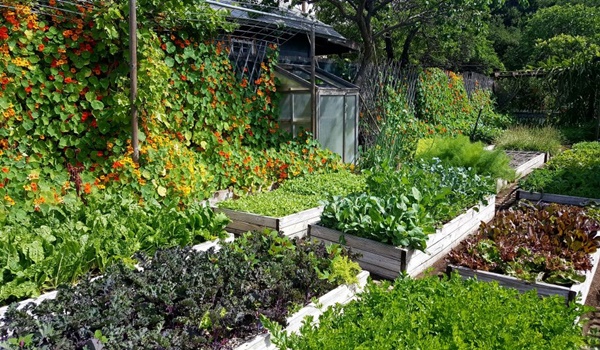A family decided to make their own mini paradise on Earth, and it is located only 15 minutes from downtown Los Angeles, 100 feet away from a major freeway, in a small city lot.
A fifth-acre lot, minus the house, garage, and driveway, the family has converted the remaining tenth of an acre into a small food forest that produces 7000 pounds of food annually with no synthetic fertilizers.
The family is supplying 90 percent of their diet spending only $2 daily per person on other staples and is making $20,000 of their excess food annually. This is all made possible by using permaculture methods which imitate the natural ones and create soil rich in bacteria and nutrients.
On the other hand, conventional agriculture methods strip nutrients from the soil, and it becomes desertified and barren, while permaculture regenerates it. Jules Dervaes moved to Pasadena in 1985, and back then, there was no soil, only adobe-like clay.
A severe drought in the 1990s made him start the garden, and since his lawn was costing him too much water, too much money and too much time, he began mulching his front lawn and planting “something useful.” Darvaes says he was just “fiddling around” until 2001 when he learned GMOs had entered the food supply. At this point, he decided to see how much food his little plot could grow.
His daughters said:
“Dad started taking over every square inch, horizontal, vertical, the frontyard, the backyard, and the driveway.”
Justin, his son, adds:
“There were no models to follow, we just did it.”
The family spent years using fermented compost, rock dust, chicken and goat manure, and effective microorganisms to revitalize the earth. They have never used synthetic NPK, and since 2007, they stopped using organic NPK fertilizers as well.
The tiny space was finally fully used with techniques for square foot gardening, they call “square inch gardening.”
It packs plants very close to each other in order to prevent evaporation from the soil and save water. The Darvaes maintain that soil should never be bare and exposed to the elements. They sew seeds as close together as possible in symbiotic arrangements.

Their website UrbanHomestead.org. recommends:
“Bigger vegetables like broccoli or peppers are planted with a carpet of greens – lettuce, arugula, etc., underneath … the green carpet acts like a living mulch, preventing weeds and keeping the soil moist.”
The efficient use of space opens an opportunity for low maintenance, and everything is done by hand, or with the help of a soil-block maker.
Jules admits:
“I believe growing food is one of the most dangerous occupations on Earth because you’re in danger of becoming free. ”
Moreover, according to Inhabitat, the simple life of this family provides the needed family income, and makes them happy, and healthy:
“The Dervaes family is able to produce about 4,300 pounds of vegetables, 900 chicken and 1,000 duck eggs, 25 pounds of honey, and further poundage of seasonal fruits on their 4,000 square-foot postage stamp of land just outside the southern California’s sprawling megalopolis. Every member of the family pitches on to make sure every square inch of their land produces as much as possible.
Moreover,
“Beyond simply producing their own organic food, the Dervaes family is living almost totally off the grid. Many of the gadgets they use are hand-powered, and what isn’t hand powered gets energy from solar panels, which leads to power bills that max out at about $12 per month. They also don’t burn any fossil fuels, as their car is powered by biodiesel produced from used cooking fat—which restaurants deliver to their doorstep.
They eat seasonally, preserve their produce, and sell directly to local restaurants where chefs are hungry for local food to meet the growing demands for 100-mile menus, which provides the Dervaes family with the extra money they need to buy the food items they can’t produce on their own.”



